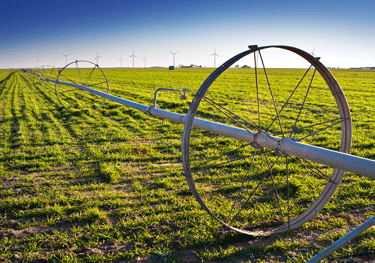Located in the Texas Panhandle, the Dockum Aquifer provides water to over forty counties. Though technically classified as a minor aquifer, the Dockum's great extent means it has the potential to become one of the most important water sources in Texas. Its water is primarily used for mining and electricity generation; it is particularly valuable for extracting oil through waterflooring. It is also a source of irrigation, municipal water, and domestic consumption. The aquifer is located within the Dockum Group, a geological formation dating back to the Triassic Era. It is connected to the High Plains, Pecos River, Edwards-Trinity, and Rita Blanca aquifers.
Composition
The Dockum Group is divided into the Santa Rosa Formation, the Tecovas Formation, the Trujillo Sandstone, and the Cooper Canyon. Most of the water can be found within the Santa Rosa Formation, which is sometimes called the Santa Rosa Aquifer. The aquifer is made up of interbedded layers of mudstone, sandstone, shale, siltstone, gravel, and conglomerate; the sandstone and conglomerate layers hold most of the recoverable water.
Salinity and hardness levels for the water in this aquifer vary wildly, ranging from less than 1,000 milligrams of total dissolved solids per liter to more than 20,000. Water from the more saline areas poses a danger to soils, limiting the aquifer's potential for irrigation in the long run. Nearby uranium supplies have made the water highly radioactive, rendering much of it too dangerous to drink. The water also contains radium-226 and -228, though in more manageable quantities. Water from the eastern outcrop areas tends to be fresher and less dangerous.
Hydrology
The Dockum Aquifer receives most of its water from precipitation, as well as from streams originating in Champion Creek and South Fork Creek. Well yields vary wildly in the Dockum Aquifer, ranging anywhere from 6 gallons per minute to 770; the average yield, however, is less than 300. In 1985, 33 million gallons of water were withdrawn from the aquifer every day. The aquifer has low storage capacity, indicating that it may not be able to provide large amounts of water in the long run.
Water Conservation
Water levels in the Dockum Aquifer have not followed a consistent trend, having declined in some areas and risen in others. The levels are particularly promising in the central portion of the aquifer, where they have risen consistently over the past few decades. In general, the quality of the aquifer's water is of greater concern than its availability.
Are you thinking about drilling for water in the Dockum Aquifer? Talon/LPE Drilling Services offers safe, affordable, eco-friendly drilling products and operations. We specialize in air and mud rotary drilling, hollow stem auger drilling, and soil boring. For more information, contact us today.

